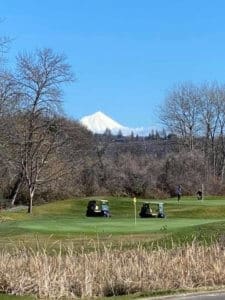You may have spent countless days venturing from hole to hole on golf courses across America, but have you stopped to consider how golf courses impact the environment and quality of life of nearby communities? In fact, properly designing and managing a golf course to positively impact the natural surroundings takes forethought, expertise, and skill. Since our initial development, we have prioritized environmental sustainability as part of our commitment to a healthy community and prosperous economy. Here’s a brief look at why you can feel good about playing golf at the Eagle Point Golf Club.
What was wrong with old-school golf courses?
In the past, golf course designers were primarily concerned about creating picture-perfect greens and fairways and, at the same time, challenging players at every hole. While golfers and their guests were awed by the scenery and perfectly manicured grass, these courses created environmental issues. Soon, courses became the target of valid societal complaints such as:
- Water runoff polluted with pesticides and fertilizers,
- Excessive water use for irrigation,
- Degradation and destruction of wildlife habitats, including wetlands,
- Eroding shorelines of streams, ponds, and coastlines, and more.
How has golf course architecture and development changed?
 Since then, the USGA has compiled several best practices for golf course development and management and has distributed over $18 million through a university grants program to learn more about potential environmental issues golf courses may have. Some of the USGA’s recommendations include:
Since then, the USGA has compiled several best practices for golf course development and management and has distributed over $18 million through a university grants program to learn more about potential environmental issues golf courses may have. Some of the USGA’s recommendations include:
- Using types of grass that require less water and are more tolerant of cold and rainy conditions.
- Implementing technology to evaluate actual irrigation needs and using state-of-the-art computer-controlled irrigation systems.
- Following best practices for local landscaping, including mulches, healthy nutrients, proper mowing heights, and soil cultivation techniques.
- Encouraging golfers to avoid venturing off the trail and playing areas, and keeping carts on designated paths.
- Collecting water runoff for future irrigation needs.
How was the Eagle Point Golf Club designed?
 Our Eagle Point Golf Club opened in 1996 as the architectural product of Robert Trent Jones, Jr. Operating with strict values of environmental sustainability, Jones designs world-class courses that protect the natural surroundings while challenging golfers of all experience levels. Each of his courses is developed according to the suitability of its landscape and the local climate conditions. Our course is no exception.
Our Eagle Point Golf Club opened in 1996 as the architectural product of Robert Trent Jones, Jr. Operating with strict values of environmental sustainability, Jones designs world-class courses that protect the natural surroundings while challenging golfers of all experience levels. Each of his courses is developed according to the suitability of its landscape and the local climate conditions. Our course is no exception.
The Eagle Point Golf Club is located in the heart of the Siskiyou Mountains. On a clear day, golfers enjoy peaceful serenity under crystal clear blue skies while gazing at majestic mountain peaks such as Mount McLoughlin. Wildlife is abundant, from grazing deer to soaring bald eagles. Because Jones implemented a system for sand veneering and water drainage in the schematics of the course, the greens and fairways hold up well, and golfers can enjoy the sport year-round.
What’s the best way to enjoy the Eagle Point Golf Club?
 Of course, golfers are always welcome to stop by and play a round of golf with us. However, why limit yourself to a few hours? After an afternoon on the course, celebrate your accomplishments at The Talon Grill. As the sun sets, you can kick back and relax in the Chalets, where you’ll enjoy a boutique lodging experience. After a good night’s sleep, you’ll be ready to get up the next day and do it all again!
Of course, golfers are always welcome to stop by and play a round of golf with us. However, why limit yourself to a few hours? After an afternoon on the course, celebrate your accomplishments at The Talon Grill. As the sun sets, you can kick back and relax in the Chalets, where you’ll enjoy a boutique lodging experience. After a good night’s sleep, you’ll be ready to get up the next day and do it all again!
If you’re interested in expanding your experience, ask our staff to help you design a customized Stay and Play getaway that includes transportation to nearby attractions. The Resort at Eagle Point is conveniently located near many local favorites, from wine tasting tours of Southern Oregon’s best vineyards to hiking to the bottom of Crater Lake. We’re looking forward to having you as our guest.

Leave a Reply